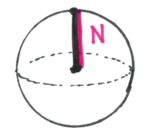I know it’s been a while1 since the last post, but we’re not quite dead yet…

I’ll explain why it’s been so long at the very end of the post, but in the meantime, we’ve got some math to explore!
The Banach-Tarski paradox says that you can take a ball, cut it up into a handful of pieces, then rearrange them in order to get two balls identical to the original.
Impossible, right?

Wrong!2
 It certainly seems impossible, though. After all, if all you do is cut up the ball, and move the pieces around (no stretching required!) then the volume of stuff from the ball shouldn’t change.
It certainly seems impossible, though. After all, if all you do is cut up the ball, and move the pieces around (no stretching required!) then the volume of stuff from the ball shouldn’t change.
But you can duplicate a ball! The trick is that rotations can create points, seemingly out of nowhere.
Here’s a simple example: Take a circle, with a single point missing.

How can we fill back in that hole? The obvious thing to do is just infinitesimally stretch the circle to fill in that single-point gap.
But let’s rule out stretching — we know that stretching things mathematically can create points. Can we do it with just a rotation?
If we pick just the right set of points to rotate, we can!
Let’s start by taking the point one radian3 clockwise of the original point. If we rotate it counterclockwise around the circle, it’ll fill the gap we had.

So, of course, that point should be in the set we will rotate. Of course, moving that point leaves another gap, so we need to also rotate the point one radian clockwise of that. And then we need another point to fill in that gap…

…and so on, and so forth.

The trick is that we picked a special angle. Recall that a circle has 360 degrees, or, equivalently, radians. If we keep picking points one radian clockwise of the original gap, we go around the circle once, then twice, then more, but we will never end up back where we started. That is because
is an irrational number! (Details in this footnote:4)

The original hole is filled by the point that was 1 radian away. The hole left at 1 radian away is filled by the point two radians away. That hole at 2 radians is filled by the point at 3 radians… and so on, so a billion radians later, the hole left by the point a billion radians away is filled in by the point a billion and one radians away.
Sure, by this point, we’ve wrapped around the circle, oooohh, say, 160 million times, but we have never repeated a point! All thanks to being irrational.
So, why isn’t there a hole at the end of all this? Well, there is no end. We’re kind of pulling a point out of infinity to fill the gap.5

Of course, creating a single point is not so impressive. So, let’s get back to the Banach-Tarski paradox.
As we talked about in the last post, the key trick is not really about geometry at all. I’m going to review some of what we discussed last time, but if you haven’t read or don’t remember Double for Nothing: the Banach-Tarski Paradox, you probably should before finishing this post.
If we take a ball, we can rotate it in different directions, forward (F), backward (B), right (R), and left (L). And, we could do multiple rotations in a row, for example, FRB would be backwards rotation, right rotation, then forward rotation.6
We can put all of these “words” representing rotations into a graph, where, for each letter in the word, F means you go up, L left, etc.. The center point, which represents no rotations, we can label N.

Thus, a series of rotations is represented by a word which is represented by a point on this branched graph. Of course, we can do any length of words (i.e., any number of rotations), so we get an infinite graph.

The “words” starting with L represent the rotations ending with a left rotation, and are the ones on the left side of the graph. (Again, words are series of rotations are points on this graph.)

The key observation from last time was that if we take the “words” starting with L, then undo the last rotation by rotating right, we end up with all the words except the ones on the right!

Where do all these extra points come from? Well, like the circle example from earlier, in some sense we’re “pulling them from infinity,” i.e., pulling them out of those infinitely small branches down in the graph.
The key of the Banach-Tarski paradox is figuring out how to get this “creation” of points on the graph to work on a ball instead.
To do that, we need to associate points in the ball with this graph somehow. Fortunately, the basic idea is not too hard. The points on the graph are supposed to represent words which represent series of rotations of a ball. Thus, we’ll try to associate each point on the graph, i.e., a word, with points on the sphere that we find via those rotations.
Grab the ball. The word that represented no rotations, N, we’ll associate with the “north pole” of the ball. The north pole, though, is just a point on the surface, and we want to duplicate the entire ball. So, let N actually represent all of the points below the north pole through the inside of the ball, all the way down to the core. (Though not including the center point at the core itself.) Thus, N represents a little line segment.

For every other series of rotations, after you rotate, the word (i.e., point on the graph) representing those rotations will represent the line from the new north pole to the center of the ball. For example, for the rotation L, you would rotate left, and that new north pole and the points under it are now “L.”

To make this all work, it’s very important that two different words, i.e. series of rotations, don’t represent the same set of points. To guarantee that, we need to pick the angle we rotate carefully. Fortunately, like in the circle rotation example earlier, it’s not too hard. One traditional angle is , but there are infinitely many angles that would work.7 If we pick that angle, each word, or series of rotations, will rotate a new point to the north pole.
Great! We’ve taken the ball and identified its points with the words, which are points on the branched graph. And those points are spread out all over the ball — it turns out you can get points spread out evenly all over the ball with an arbitrary number of rotations.
Except…
Well, we’ve actually missed almost all the points of the ball!

Even though our words represent points that are evenly spread out all of the ball, so that it would look like we’ve covered everything, we’re actually missing “most” of the points in the ball!8
Fortunately, there’s an easy way to fix this.

Simply pick one of the points we missed on our first go, and start again with that point as the new north pole. We can associate the word N (for no rotations) with both this north pole and the original one we picked. Then, we can do all the rotations, like before, and associate their words with the new points as well. After doing this, we’ll have two line segments of points from the surface to the middle of the ball for each “word” like N or FR or BBBR, but we’ll lump them together into one set of points.
Unfortunately, we’re still missing most of the points in the ball. So, we pick yet another new north pole from the leftover points, and do it again. And again, and again. In fact, we have to do it infinitely many times.9

But, in any case, we’ve split up the ball into a bunch of pieces. For instance, N is associated with all the infinitely many “north poles” we picked, along with the line segment underneath them, and a similar set of line segments for every other word, or set of rotations.

Now we can use the trick from the last post.
Let’s call the set the set of all the points and line segments in the ball represented by words that start with L, i.e., where the last rotation was to the left. We can similarly define
,
, and
. The set
will just represent all the points associated with the north poles.
The set is all the points found by rotating the sphere, where the last rotation was to the left. So, if we take all those points, and rotate them to the right to undo that last rotation, as with the graph, we get all the points in
,
,
, and
, exactly like we did for the branched graph! As before, we call the left-last points, rotated right,
.
We can do a similar thing, and , the points found by rotating backwards last, but then having that last rotation undone, is all the points in
,
,
, and
put together!
That, right there, is the heart of the Banach-Tarski paradox.

It’s easy to get the two balls from what we’ve done. To make the first ball, take all the points in and
, rotate
to the right to get
, then put
and
together, and you have a ball! The second ball is similar: take all the points in
and
, rotate
forward to get
, then put those two sets together, and you have the second ball!

So, there you have it. By cutting up the sphere into a few pieces, and then just rotating and moving them around, you can turn one ball into two!

Admittedly, we’ve glossed over a few important details if you want this to work out perfectly, but I think they can be hidden in a footnote.4
This is quite the paradox! You shouldn’t be able to cut a ball into pieces and put them back into two spheres!

From a physical point of view, this process is, of course, impossible. Not only are the sets we’re cutting the ball into hopelessly complicated and delicate, but they assume that matter is infinitely divisible, which is false. (Subatomic particles are, after all, a particular size, and it’s hard to cut a quark into pieces…)
But even from a mathematical view point, this seems like it shouldn’t work. And, so, if we think that way, we can look back at our assumptions, and see which of the axioms we used seems the most questionable, and try to get rid of that assumption.
What’s fascinating about this proof is that the key problematic axiom is so innocuous that, if you didn’t know what you were looking for, you would probably never find it. The step that is the most questionable is the one where we choose points as new north poles.

The thing is, when we make that choice, there’s no reason to pick one point over another. They’re all just as good as any other. Plus, we have to make infinitely many of these choices, which is also a bit… uncomfortable.

Doing this requires the Axiom of Choice, perhaps the most infamous axiom in mathematics.
And all it says is that you can choose things.
In the next post, we’ll take a look at the axiom of choice and why it’s so important… and infamous. (Assuming the Missus can find the time to draw…)

An excellent video on this paradox, and its proof, can be found on Vsauce’s Youtube channel. In the description, he also lists many resources which I found useful in preparing this post.
Oh, life plans. How fleeting they are.
Since the last post, we’ve had Thanksgiving, a funeral with associated trip, finals, the flu, bad colds, Christmas, the start of a new term, 10 interviews, and so forth. It’s been… busy. That would explain some of it. But another big thing is the complete upheaval of my life plans!
See, to become a professor, after you get a PhD, you usually spend 2 or 3 years at one or two universities as a “postdoc,” which is what I am now. These positions are temporary, and are not expected to lead to permanent positions at said universities.
So, I applied to permanent jobs this school year. Lots of them. I had a bunch of interviews, but I didn’t end up getting hired as a professor.

I could probably scramble and get another postdoc at another university and then do another cycle or two of applications for professor jobs, but… well, academia is stressful. Awesome, to be sure, but stressful too. (When I talked to my mentor about his career path, his frequent use of the phrase “panic mode” didn’t exactly encourage me.)

So, after a lot of thought, I’ve decided to leave academia, and become a computer programmer instead. Of course, since I have limited experience, that means I have till my contract at the university ends to learn enough programming to get hired somewhere. It turns out that covering years of computer science education on my own is time-consuming.
For obvious reasons, then, this blog, though it will probably continue, is going to be updated less frequently in the coming year.
First post in this series: How Long is Infinity?
–> Next Post: The most controversial axiom of all time
- The Missus, here: it was my fault. Apparently one cannot blog without cute pictures from wife. ↩
- Well, okay, in real life, it’s not like you’re going to be able to duplicate balls of gold with this in a get-rich-scheme or anything, but mathematically it works! ↩
- In case you’ve forgotten, radians are just another unit for measuring angles, like Fahrenheit and Celsius are different units for measuring temperature. By definition, a circle has 360 degrees, or
radians. A triangle’s angles (on a flat surface) add up to 180 degrees, or
radians. ↩
- Well, even here, I won’t go over the details of the proof, but I’ll at least mention some things we glossed over. The most obvious is, perhaps, that we never worried about the very center points of the sphere. You can take care of that with a trick like we did by rotating the circle to fill in a point. Also, you may not have noticed, but we only used
,
,
, and
in making the two copies. We never used the original copy of
! So, actually, we ended up with 2 spheres, plus some left over stuff. If you cut up the sphere in a slightly more complicated way (it’s not that bad), you can make sure you don’t end up with this junk. The most subtle problem is that not all points of the ball rotate when we do our rotations. This ends up meaning that we’ve missed some points. But there’s a way to take care of these points as well. More details can be found on the Wikpedia page, or in this short paper. ↩ ↩
- This boils down to a variation of the Hilbert’s Hotel paradox, which we talked about way back in our very first post, Infinity plus one. ↩
- Recall that we don’t allow letter combinations that would undo each other, like LR or BF. ↩
- It takes a bit more work than the circle example to be one hundred percent sure that points don’t overlap after any rotation, but this angle was chosen since it makes the math not too horrible. A proof that it doesn’t overlap can be found on the second and third page of this paper. ↩
- The fundamental problem is that our rotations only let us get countably many points on the surface of the ball, while the surface itself has uncountably many points. As we talked about in How Long is Infinity?, countably many is essentially nothing compared to uncountably many. ↩
- More specifically, we have to do it uncountably infinite times in order to get them all. ↩

Best of luck with your switch to CS! Judging from your blog, you are an excellent educator, and will make a great programmer. One day you might even teach CS. 😉
I love that you and Missus make such a great team (I love her illustrations: it really livens up the post). All the best wishes to you two and your epsilons!
LikeLike
Good luck with your applications! I’ll finish (hopefully) my PhD in maths next year and the job prospects are pretty scary. And before everyone kept saying: “With PhD in maths from [very-good-university] you won’t have to worry about your future”…
LikeLike
Oh, it’s true you don’t have to worry about your future. Your future just might not be what you had in mind…
The problem with random people comforting you about prospects in academia is that they’re comparing you to people in normal, every-day jobs. Because you are better at math than any of them, how could you fail to get a job in academia? But, in academia, EVERYONE is better at math than any of them…
Ah, well. Plenty of other jobs out there.
LikeLike
Good point, I’m afraid.
By the way, have you considered a career in maths education/communication? You’re really good at explaining very difficult concepts to non-mathematicians without dumbing it down. I know it’s none of my business, I’m asking out of curiosity, and because I’m considering it myself.
LikeLike
Wow! I’m really glad I got to have you as my instructor before you left academia. You are a talented teacher and the best one I took here by far. I don’t even know if I could have finished my final year without you renewing my vigor (I still have 10 weeks, but I’m hopeful).
Best of luck with programming, I’m sure you’ll be great at it! The math background will certainly help. The company for which I work as a developer openly accepts people with pure math degrees even if they don’t have a ton of experience coding. People with math degrees get a lot of love out there in the business world, believe it or not.
LikeLike
Re Banach-Tarski, in addition to the 4 points on the equator fixed by L, R, F, B shouldn’t there also be (a countable infinity of) other points that are fixed by certain combinations? For example, look at intersections of
1. the great circle = L^(1/2) of the equator with
2. the great circle = B^(1/2) of the equator.
Then under BR (and its inverse) (acting on the right) each should trace out a ()-looking closed loop of minor arcs straddling the equator. The opposite tips of those loops would be likewise be fixed by RB and FL. And another set of similar points could be found by changing L to R in 1. Or look at the intersections of
1. B^(1/2) of (great circle though N and points
fixed by F, B) with
2. R^(1/2) of (great circle though N and points
fixed by L, R).
Then under RBLF and its inverse they should trace out a square of minor arcs centered around the poles returning to themselves. (The interceding corners of those squares will in turn be fixed by successive right rotations of RBLF).
So off the cuff that’s 12 other fixed points easily extendable to a countable infinity
LikeLike